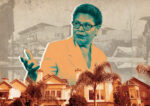Trending
Closings set to begin today in Stein slay case

Closing arguments are set to commence today at 100 Centre Street in the murder trial of Natavia Lowery (middle) who is accused of killing her former boss, Linda Stein (right)
The murder case against the personal assistant to celebrity real estate broker Linda Stein will go to closing arguments today and then onto the jury for a verdict without so much as one witness being presented by the defense.
Before resting its case on Thursday, the prosecution introduced one final piece of evidence that will probably take center stage in the government’s summations today. A set of photographs were submitted for the jurors to look at when they start deliberations but no further explanation was given at the time.
Today, prosecutors will point out the fact that the photos, stills taken from the security camera system at Stein’s Fifth Avenue building on the day she was bludgeoned to death, show personal assistant Natavia Lowery, 28, entering the building wearing her pants normally and leaving later that day with those pants turned inside-out. What other reason would Lowery have to wear her pants like that aside from trying to hide blood stains, the prosecutors are expected to say to the jury.
It’s to be seen if Lowery’s attorney’s have any such “a-ha” moments up their sleeves. But at this point summation is all they have left because on Thursday Lowery’s defense team announced that it would not be putting on any witnesses and rested its case. Her attorneys could not be reached for comment.
Dino Lombardi, a criminal defense attorney who was previously a Brooklyn and Queens prosecutor, told The Real Deal that it was “very rare” that defense attorneys with a client facing serious prison time would decide to forgo presenting their side of the case.
“The reason why you would [not call any witnesses] is that you want to show the jury you’re being absolutely dismissive of the prosecution’s case,” Lombardi said. “’The prosecution hasn’t come close to proving their case, so I ‘m not even going to put anyone on.’ But from what I read it appears that the prosecution put on an overwhelming case. So it is a bit surprising.”
At the same time, Lombardi said, it’s tough to second guess a defense team because only it knows what type of rebuttal it could have presented. For instance, he said, it’s possible that in their pre-trial preparation the defense attorneys found out that Lowery was a loose cannon and putting her on the stand might be more of detriment than a help for her cause. But still, usually in a murder case the defense will present some witnesses to, at the very least, try to make a client appear more sympathetic to the jury, he said.
When the murder case against Lowery opened Jan. 25 in Manhattan Supreme Court, Judge Richard Carruthers told the jury to expect the trial to last about eight weeks. But with the defense’s decision not to call witnesses, the trial ended anti-climatically in half that time on Friday with the judge making some legal rulings on what sub-charges the jurors would be allowed to consider when deciding Lowery’s guilt or innocence.
On that front, defense attorneys Thomas Giovanni and John Christie did win one point for their client, who is accused of stealing from and then bludgeoning Stein to death with what prosecutors allege was a weighted yoga stick Oct. 30, 2007.
The judge agreed with the defense’s request on Friday to allow the jurors, if they so choose, to consider convicting Lowery of manslaughter in the first degree instead of murder in the second degree. The prosecutors unsuccessfully argued that the only charge jurors should be allowed to consider was murder in the second degree, which carries a mandatory 25 years to life sentence. Manslaughter in the first degree, meanwhile, carries a five- to 25-year sentence.
But the judge ruled out the defense’s request to allow the jury to also consider manslaughter in the second degree, which carries a 3.5- to 15-year sentence, based on allegations of Lowery being the victim of Stein’s marijuana smoking. The defense argued that Lowery was “intoxicated” and didn’t know what she was doing at the time of the attack because Stein, who transformed herself from a former punk rock group manager into one of Prudential Douglas Elliman’s biggest earning brokers, blew marijuana smoke in her face.
“There were a minimum of 24 blows administered to the deceased; most of the blows were sustained to the head. There’s no room for argument,” Carruthers said Friday while also pointing out that autopsy tests found no evidence of marijuana in Stein’s blood system.
The judge’s assessment was primarily based on the testimony of medical examiner Michael Sloane who said Thursday that Stein was struck at least 24 times and that her attacker not only probably paralyzed her but stood on the fallen 62-year-old woman’s back and continued to hit her.
Sloane was the final witness in a case that has featured phone records, bank records, cell phone tower and subway card records to track movement, security camera footage, witnesses whose testimony has contradicted the personal assistant’s version of events and videotaped and written confessions all seemingly implicating Lowery in the murder of Stein.
In their cross examinations, Lowery’s defense attorneys have attacked the admissions, both written and videotaped, that Lowery made confessing to the slaying, saying they were coerced or fabricated. Without having put on their own witnesses or offering an alternative suspect, Lowery’s defense team will have to win the trial in summations.
Lombardi, the former prosecutor, said he’d be surprised if the defense was able to pull this case out of a hat at closings.
“The prevailing wisdom is that a defense attorney can win a trial at openings but not at summations. A well thought out, intelligent opening can make a jury question a prosecution and really twist their heads around; ‘that’s right, [the defense attorney] said they wouldn’t be able to prove that and they didn’t.’ But being able to overcome weeks of uncontested or nearly uncontested testimony and evidence with a closing argument — that just doesn’t happen.”




